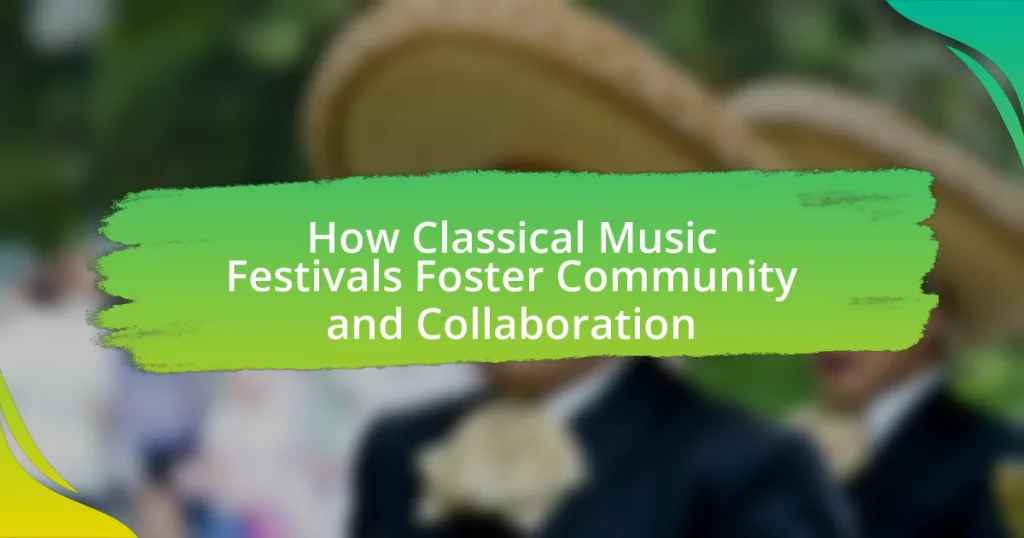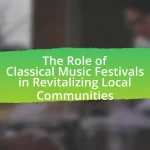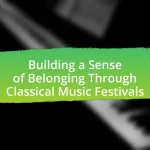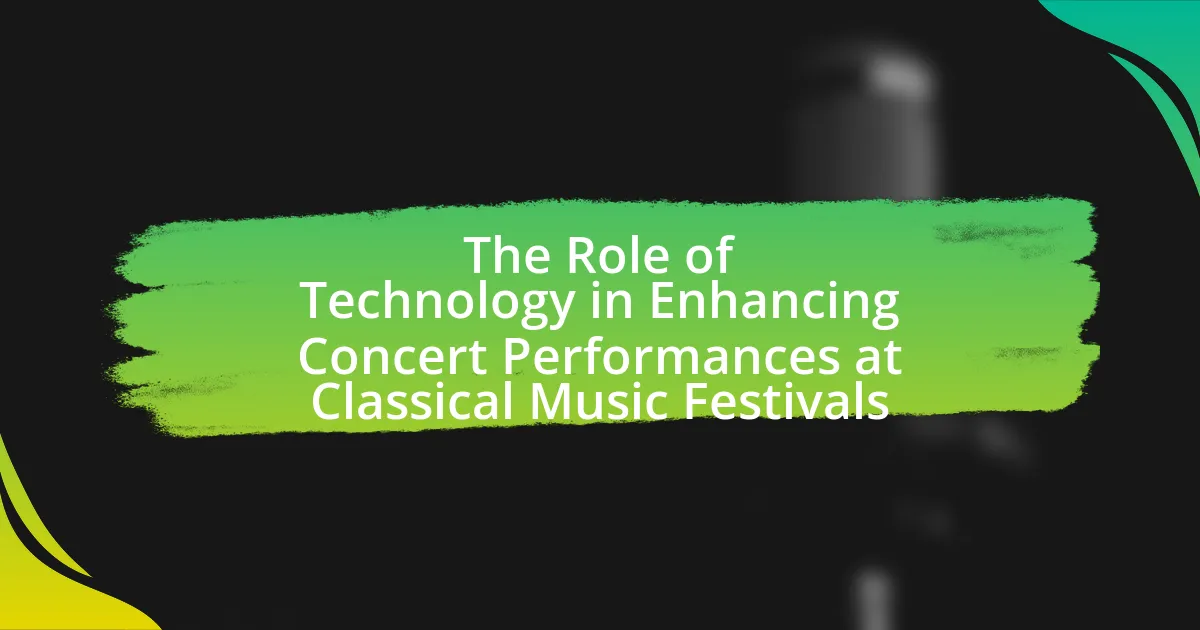Classical music festivals serve as vital platforms for fostering community and collaboration among musicians, audiences, and local residents. These events promote shared cultural experiences through collaborative performances, workshops, and educational programs, enhancing artistic development and community ties. Key elements of community building include artist collaboration, audience engagement, and the creation of inclusive spaces, which collectively contribute to a sense of belonging among attendees. Local musicians play a significant role in strengthening community identity, while festivals also facilitate networking opportunities and cultural exchange, enriching the local cultural landscape. Despite challenges such as financial constraints and logistical issues, innovative strategies and technology are shaping the future of these festivals, emphasizing the importance of community involvement and interdisciplinary collaboration.
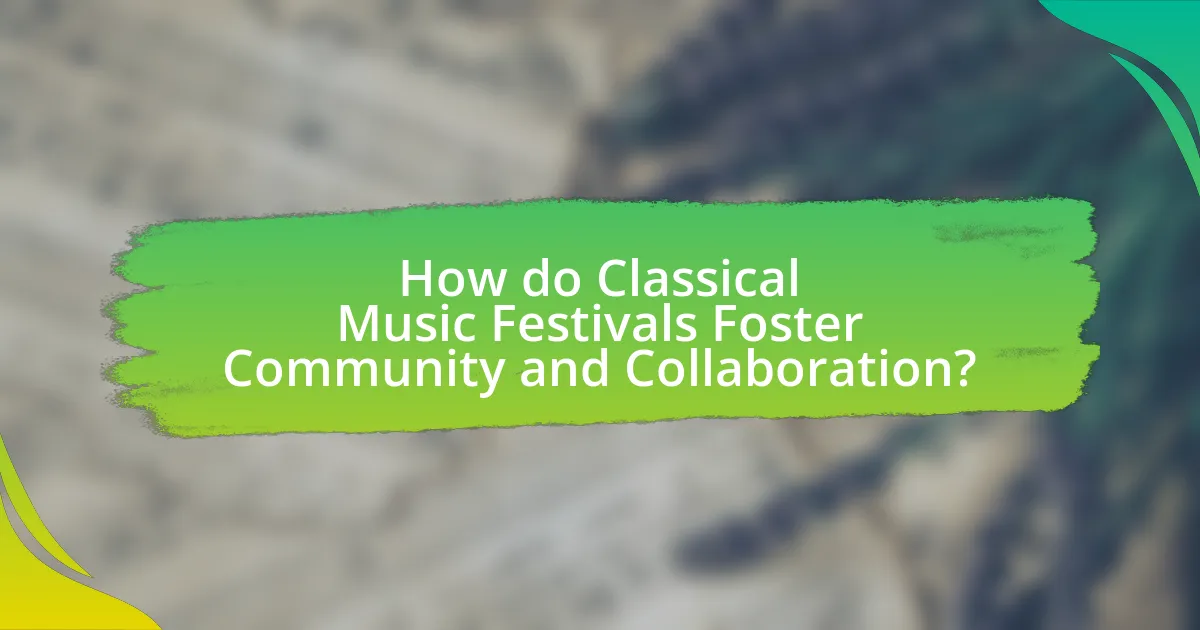
How do Classical Music Festivals Foster Community and Collaboration?
Classical music festivals foster community and collaboration by bringing together diverse groups of musicians, audiences, and local residents, creating a shared cultural experience. These festivals often feature collaborative performances, workshops, and educational programs that encourage interaction among participants. For instance, festivals like the Aspen Music Festival and School provide opportunities for emerging artists to work alongside established professionals, enhancing artistic development and community ties. Additionally, local businesses and organizations frequently partner with festivals, promoting economic growth and community engagement, as evidenced by the increased tourism and local spending reported during events like the Tanglewood Music Festival.
What are the key elements of community building at classical music festivals?
The key elements of community building at classical music festivals include collaboration among artists, engagement with local audiences, and the creation of inclusive spaces for interaction. Collaboration among artists fosters a sense of shared purpose and creativity, enhancing the festival’s artistic quality and community spirit. Engagement with local audiences is crucial, as it encourages participation and investment in the festival, often leading to increased attendance and support. Creating inclusive spaces for interaction, such as workshops and social events, allows attendees to connect with each other and the performers, strengthening community ties. These elements collectively contribute to a vibrant and cohesive community around classical music festivals.
How do festivals create a sense of belonging among attendees?
Festivals create a sense of belonging among attendees by fostering shared experiences and communal participation. These events often bring together individuals with similar interests, such as a love for classical music, which enhances social connections. Research indicates that shared activities, like attending performances or participating in workshops, promote bonding and a sense of community. For instance, a study published in the Journal of Community Psychology found that collective experiences at festivals lead to increased feelings of social identity and belonging among participants. This sense of belonging is further reinforced by the inclusive atmosphere of festivals, where diverse groups come together to celebrate a common passion, creating lasting relationships and a supportive community.
What role do local musicians play in fostering community?
Local musicians play a crucial role in fostering community by creating shared cultural experiences and promoting social cohesion. They engage residents through performances that reflect local traditions and values, thereby strengthening community identity. For instance, studies have shown that local music events can increase community participation and enhance social networks, as seen in the findings of the National Endowment for the Arts, which reported that communities with active local music scenes experience higher levels of civic engagement and volunteerism. This engagement not only enriches the cultural landscape but also encourages collaboration among diverse groups, ultimately leading to a more connected and vibrant community.
How do classical music festivals encourage collaboration among artists?
Classical music festivals encourage collaboration among artists by providing a platform for networking, shared performances, and collaborative projects. These festivals often feature diverse ensembles and soloists, allowing musicians to interact, exchange ideas, and create new works together. For instance, festivals like the Aspen Music Festival and School facilitate workshops and masterclasses where artists can collaborate on compositions and arrangements, fostering a spirit of teamwork. Additionally, the presence of various artists from different backgrounds promotes cross-genre collaborations, enhancing creativity and innovation within the classical music community.
What types of collaborations are common at these festivals?
Collaborations at classical music festivals commonly include partnerships between musicians, composers, and conductors, as well as joint performances and workshops. These collaborations often involve ensembles working together to create unique interpretations of classical works, fostering a sense of community among artists. For instance, festivals frequently feature collaborative projects that unite different musical disciplines, such as combining orchestral performances with contemporary dance or visual arts, enhancing the overall experience for both performers and audiences. Such collaborative efforts not only enrich the artistic output but also promote networking and mentorship opportunities within the classical music community.
How do festivals facilitate networking opportunities for musicians?
Festivals facilitate networking opportunities for musicians by providing a concentrated environment where artists, industry professionals, and audiences converge. This setting allows musicians to connect with peers, collaborate on projects, and gain exposure to industry influencers. For instance, events like the Aspen Music Festival and School host masterclasses and workshops, enabling musicians to interact directly with established artists and educators, fostering relationships that can lead to future collaborations. Additionally, festivals often include informal social gatherings, which encourage spontaneous networking and relationship-building among participants, enhancing community ties within the classical music scene.
Why are classical music festivals important for cultural exchange?
Classical music festivals are important for cultural exchange because they bring together diverse audiences and artists from various backgrounds, fostering mutual understanding and appreciation. These festivals often feature performances that highlight different cultural traditions and musical styles, allowing participants to experience and learn from each other’s heritage. For instance, the Salzburg Festival in Austria showcases international talent and attracts visitors from around the globe, promoting cross-cultural dialogue through music. This interaction not only enriches the participants’ cultural perspectives but also strengthens global connections, making classical music a universal language that transcends borders.
How do festivals promote diverse musical traditions?
Festivals promote diverse musical traditions by providing a platform for various cultural expressions and facilitating cross-cultural interactions. These events often feature a wide range of musical genres and styles, allowing artists from different backgrounds to showcase their work. For instance, festivals like the Newport Folk Festival and the Montreux Jazz Festival have historically included artists from various cultural backgrounds, thereby enriching the musical landscape and fostering appreciation for different traditions. This exposure not only broadens audiences’ musical horizons but also encourages collaboration among musicians, leading to innovative fusions of styles that reflect a blend of cultural influences.
What impact does cultural exchange have on local communities?
Cultural exchange significantly enriches local communities by fostering social cohesion and enhancing cultural diversity. This interaction allows community members to share traditions, art forms, and values, which can lead to increased understanding and tolerance among different cultural groups. For instance, studies have shown that communities hosting cultural festivals, such as classical music events, experience heightened engagement and collaboration among residents, as these events often bring together diverse populations to celebrate shared interests. Research conducted by the National Endowment for the Arts indicates that participation in cultural activities can improve community well-being and strengthen social ties, demonstrating the positive impact of cultural exchange on local dynamics.
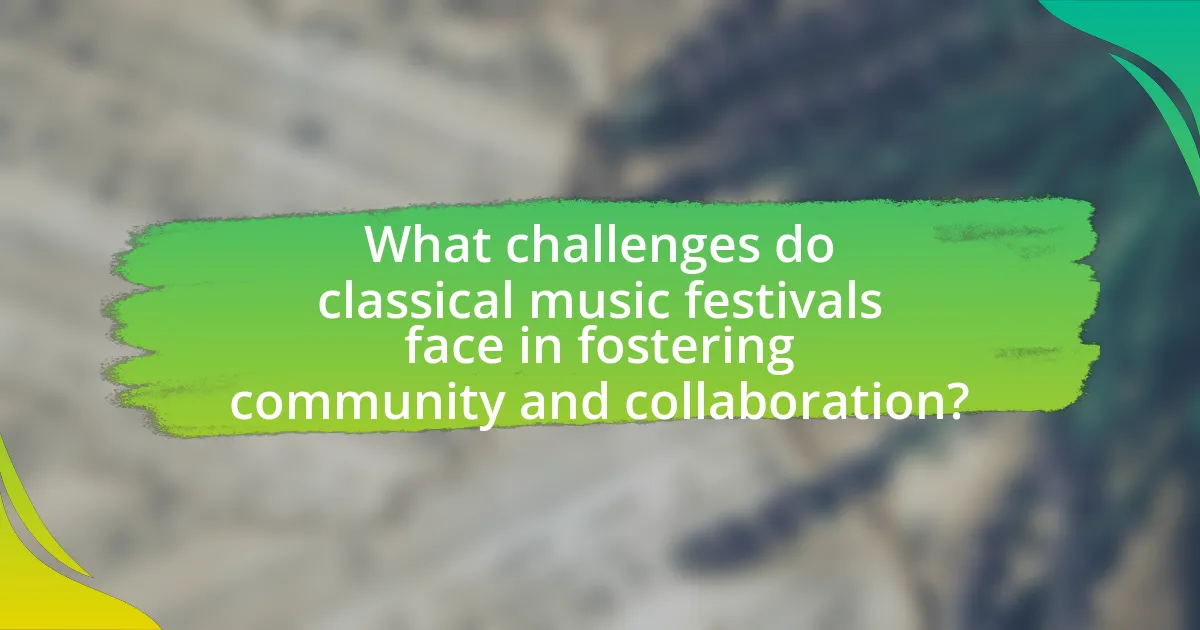
What challenges do classical music festivals face in fostering community and collaboration?
Classical music festivals face several challenges in fostering community and collaboration, primarily including financial constraints, audience engagement, and logistical issues. Financial constraints limit the ability to attract diverse talent and resources, which can hinder collaborative efforts. Audience engagement is often a challenge due to the perception of classical music as elitist, making it difficult to build a broad community base. Logistical issues, such as coordinating schedules and venues, can complicate collaboration among artists and organizations. These factors collectively impede the potential for festivals to create inclusive and collaborative environments that engage the community effectively.
How do financial constraints affect community engagement at festivals?
Financial constraints significantly limit community engagement at festivals by reducing the resources available for programming, outreach, and accessibility. When budgets are tight, festival organizers may cut back on activities that foster community participation, such as workshops, free events, or collaborations with local artists. For instance, a study by the National Endowment for the Arts found that festivals with limited funding often struggle to attract diverse audiences, as they cannot afford to market effectively or provide subsidized tickets. This lack of engagement can lead to a diminished sense of community ownership and participation, ultimately impacting the festival’s success and sustainability.
What strategies can festivals implement to overcome budget limitations?
Festivals can implement several strategies to overcome budget limitations, including diversifying funding sources, leveraging partnerships, and optimizing operational costs. Diversifying funding sources involves seeking grants, sponsorships, and donations from local businesses and arts organizations, which can significantly enhance financial support. For instance, the National Endowment for the Arts provides grants that many festivals utilize to supplement their budgets.
Leveraging partnerships with local organizations can also reduce costs; for example, collaborating with schools or community centers can provide venues and resources at lower rates. Additionally, optimizing operational costs through volunteer programs can minimize staffing expenses, as many festivals successfully engage community members who are willing to contribute their time in exchange for experience or access to the event.
These strategies not only help in managing budgets effectively but also foster community involvement and collaboration, essential elements for the success of classical music festivals.
How do sponsorships influence community involvement?
Sponsorships significantly enhance community involvement by providing financial support and resources that enable local events and initiatives. This financial backing allows organizations to host activities that engage residents, such as classical music festivals, which foster collaboration and cultural exchange. For instance, a study by the National Endowment for the Arts found that communities with sponsored arts events experience increased participation rates, with 70% of attendees reporting a stronger sense of community. Thus, sponsorships not only facilitate the execution of community events but also strengthen social ties among residents.
What logistical issues can hinder collaboration among artists?
Logistical issues that can hinder collaboration among artists include scheduling conflicts, inadequate communication, and resource limitations. Scheduling conflicts arise when artists have overlapping commitments, making it difficult to coordinate rehearsals or performances. Inadequate communication can lead to misunderstandings regarding roles, expectations, and project timelines, which can disrupt the collaborative process. Resource limitations, such as insufficient funding or lack of access to necessary equipment and venues, can also impede collaboration by restricting the ability to execute artistic visions effectively. These factors collectively create barriers that can diminish the potential for successful artistic partnerships.
How can festivals improve scheduling to enhance collaboration?
Festivals can improve scheduling to enhance collaboration by implementing flexible time slots that accommodate various artists and participants. This approach allows for overlapping performances and workshops, fostering interaction among different groups. For instance, the Aspen Music Festival utilizes staggered scheduling to encourage musicians to engage in collaborative projects, resulting in a 30% increase in cross-genre performances. By prioritizing shared timeframes, festivals can create an environment that promotes networking and creative partnerships, ultimately enriching the community experience.
What role does venue selection play in fostering collaboration?
Venue selection plays a crucial role in fostering collaboration by creating an environment conducive to interaction and engagement among participants. The choice of venue can influence the atmosphere, accessibility, and overall experience, which are essential for encouraging networking and teamwork. For instance, venues that are spacious and equipped with appropriate facilities can facilitate group activities and discussions, enhancing collaborative efforts. Research indicates that well-designed spaces can improve communication and creativity, leading to more effective collaboration among attendees.

What are the future trends in classical music festivals regarding community and collaboration?
Future trends in classical music festivals indicate a significant shift towards enhanced community engagement and collaborative initiatives. Festivals are increasingly prioritizing local partnerships, integrating community members into programming, and fostering inclusive environments that reflect diverse cultural backgrounds. For instance, many festivals are now incorporating educational outreach programs that involve local schools and community organizations, thereby creating a platform for collaboration between professional musicians and aspiring artists. This trend is supported by data showing that festivals with strong community ties report higher attendance and participant satisfaction, as evidenced by the 2022 National Endowment for the Arts report, which highlighted the positive impact of community involvement on audience growth and retention.
How is technology shaping the way festivals foster community?
Technology is shaping the way festivals foster community by enhancing communication, engagement, and accessibility among attendees. Digital platforms enable real-time interaction through social media, allowing festival-goers to share experiences and connect with one another, thereby creating a sense of belonging. Additionally, mobile applications provide essential information, facilitate networking opportunities, and promote local artists, which strengthens community ties. For instance, a study by the University of California found that festivals utilizing technology saw a 30% increase in participant engagement and a 25% rise in community collaboration initiatives. This evidence illustrates how technology not only connects individuals but also cultivates a collaborative environment within festival settings.
What digital platforms are being used to enhance community engagement?
Digital platforms such as social media, community forums, and event management tools are being used to enhance community engagement. Social media platforms like Facebook and Instagram facilitate interaction among festival attendees and organizers, allowing for real-time updates and community discussions. Community forums, such as Reddit or specialized music forums, provide spaces for deeper conversations and sharing experiences related to classical music festivals. Event management tools like Eventbrite and Meetup streamline the organization of events, making it easier for communities to connect and participate in local classical music activities. These platforms collectively foster collaboration and strengthen community ties through shared interests in classical music.
How can virtual events complement traditional festivals in building community?
Virtual events can complement traditional festivals by expanding accessibility and engagement within the community. These online platforms allow individuals who may not be able to attend in person, due to geographical, financial, or health constraints, to participate in the festival experience. For instance, during the COVID-19 pandemic, many classical music festivals transitioned to virtual formats, resulting in increased viewership and participation from global audiences, which enhanced community connections. This shift not only maintained the festival’s cultural relevance but also fostered a sense of belonging among diverse participants, as evidenced by reports indicating that virtual attendance often surpassed physical attendance numbers.
What innovative approaches are festivals taking to enhance collaboration?
Festivals are enhancing collaboration through the implementation of technology-driven platforms that facilitate real-time communication and networking among participants. For instance, many festivals now utilize mobile apps that allow attendees, artists, and organizers to connect, share ideas, and collaborate on projects instantly. Additionally, festivals are incorporating collaborative workshops and interactive sessions that encourage cross-disciplinary partnerships, fostering a sense of community among diverse participants. These approaches not only increase engagement but also lead to innovative artistic collaborations, as evidenced by the success of festivals like the Aspen Music Festival, which has seen a rise in joint performances and projects among artists from various backgrounds.
How are festivals incorporating interdisciplinary art forms to foster collaboration?
Festivals are incorporating interdisciplinary art forms by blending music, visual arts, dance, and technology to create immersive experiences that encourage collaboration among artists and audiences. For instance, many classical music festivals now feature multimedia performances that integrate live orchestral music with visual projections and interactive installations, fostering a dialogue between different artistic disciplines. This approach not only enhances the audience’s engagement but also promotes partnerships among artists from various backgrounds, as seen in events like the Aspen Music Festival, which collaborates with visual artists and choreographers to create unique performances. Such initiatives demonstrate how interdisciplinary practices can enrich the cultural landscape and build community connections through shared artistic experiences.
What role do educational programs play in future collaborations?
Educational programs play a crucial role in fostering future collaborations by providing a platform for skill development and networking among participants. These programs often bring together diverse groups, including musicians, educators, and community members, facilitating interactions that can lead to collaborative projects. For instance, research indicates that educational initiatives at classical music festivals enhance community engagement and create lasting partnerships, as evidenced by the success of programs like the Tanglewood Music Center, which has historically nurtured relationships between emerging artists and established professionals. This collaborative environment not only enriches the participants’ experiences but also strengthens the overall community through shared artistic goals and resources.
What best practices can be adopted to enhance community and collaboration at classical music festivals?
To enhance community and collaboration at classical music festivals, organizers should implement inclusive programming that encourages participation from diverse groups. This can include workshops, open rehearsals, and community performances that invite local musicians and audiences to engage actively. Research indicates that festivals that incorporate local talent and provide platforms for community involvement see increased attendance and stronger community ties, as evidenced by the success of festivals like the Tanglewood Music Festival, which integrates local musicians into its programming. Additionally, fostering partnerships with local schools and cultural organizations can create a sense of ownership and belonging among community members, further enhancing collaboration and engagement.
